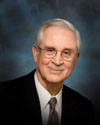
Fall 2006 - Vol.1, No.2
Many Thanks, and Two Regrets
Lawrence I. Bonchek, M.D., F.A.C.S., F.A.C.C.
Editor in Chief
The months since the appearance of the first issue of this Journal have been busy and gratifying, though in
two small ways disappointing. Busy, of course, as we plan future issues. Gratifying, because so many of you have told us you enjoy receiving the Journal, and think it has considerable style and scientific value.
I extend special thanks to the many members of the Medical Staff who want to contribute articles in the future; Gina Bissett and I have been busy meeting with many of you. One disappointment, if I can call it that, has come from those few who expressed surprise that the LGH Medical and Administrative Staffs could produce such sophisticated and informative articles. That this attitude still persists in some corners confirms something I emphasized in my first Editorial column: “It is long past time for LGH to be recognized for our enviable and often unheralded record of important clinical research and innovation.”
The deep resources of intellect and ability at LGH are some of the main reasons I was so optimistic when I came here in 1983 to start the open heart surgery program, and why I enthusiastically endorsed Tom Beeman’s recent suggestion that we develop this Journal. If further proof of our Medical Staff’s intellectual resources were needed, how about this? The December 2006 issue will be devoted to a single topic: the vast amount of information that has accumulated recently about Vitamin D, calcium, and multiple organ systems and body processes. When it comes to Vitamin D and calcium, to paraphrase a well-worn
expression, “It’s not just about the bones, stupid!” Having thus already identified the articles for the December issue, the fourth issue for March 2007 is filling rapidly.
I also regret that we haven’t received letters with questions, criticisms, or suggestions for improvements in the Journal. Your compliments are appreciated, of course, but we know we’re not perfect, so please let us hear from you, positively or negatively, and please tell us whether you want your letter considered for publication.
As for the current issue: we again offer four major clinical articles. I draw your attention in particular to a
major review of sepsis management by Dr. Joe Kontra of Infection Specialists of Lancaster, because it introduces a new sepsis management program at Lancaster General Hospital. This program has been stimulated by a national campaign to introduce guidelines for the management of sepsis. Despite intense research, sepsis remains a major cause of mortality; it causes 200,000 deaths annually, rivaling acute myocardial infarction (225,000 deaths) and stroke (163,000 deaths).
We also have our usual Comment from Family Practice by Alan Peterson, whose topic this issue is Omega-3 fatty acid supplements. In the remaining “Departments,” Senior Vice President Tom Paisley takes over the Administration Page to talk about the new hospital Strategic Plan that will involve all of us in its execution over the next several years; Chief of Staff Dave Polin explains why the Medical Staff Organization needs to change if it is going to cope with the changing face of medical practice; and General Counsel Bob Macina discusses the difficult legal issues surrounding withdrawal of support from patients who have been declared brain dead.
I also draw your attention to the CD inside the back cover, which again features two interviews. In the first, I talk with Mary Grace Simcox, President of the Lancaster General College of Nursing and Health Sciences, about the remarkable and fascinating transition of our venerable nursing diploma school into an accredited junior college. In the second, I talk with Joe Kontra about the looming specter of Avian flu. This potential global pandemic has a historical precedent in the lethal flu of 1918-19, a global pandemic that is now known to have originated in birds. Known in the United States as the Spanish flu or “La Grippe” because it ravaged Spain early on, estimates of the worldwide mortality from that pandemic ranged from 20 to 100 million people.